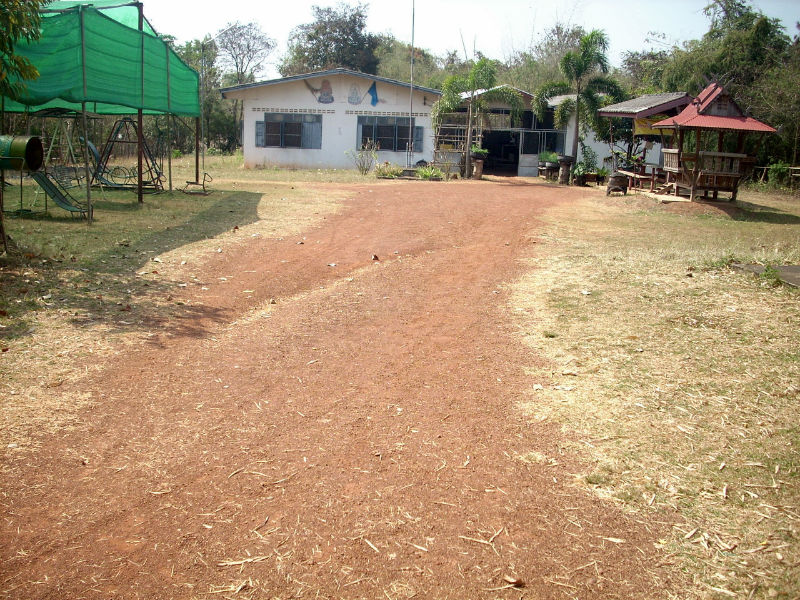Location
Ban Sawang, Province of Sakon Nakon, North Eastern Thailand
 Community Description
Community Description
Ban Sawang is located in North-Eastern Thailand, in the region referred to as Isan, approximately 50 miles from the Laos border.
Ban Sawang is a small village of 524 people in the poorest area of Thailand. It is a rice farming community that has few resources, and no businesses to speak of. The area has poor soil and only one crop can be harvested per year due to the weather.
Ban Sawang has a single elementary school and a preschool. Ban Sawang Preschool serves 40 children. The rainy season lasts for three months and almost daily there are torrential downpours. During these months, the preschool is flooded and creates an unhealthy situation for the children and teachers.
The area has a large amount of Dengue fever every rainy season. Standing water in the preschool creates an ideal breeding ground for the Dengue mosquito as well as harmful bacteria.
The school has two water-related issues that need attention. The first is a flooding problem that creates standing water. The preschool is built at the bottom of a slope. During the rainy season, water runs into the school, and the water has no place to drain. The teachers also report that dangerous water snakes enter the school.
 The second issue that needs resolution is a drain problem in the bathing room of the preschool. This is an area where the children bathe themself daily. It is currently unusable because the water will not drain. There is an existing drain but the soil foundation has shifted and the plumbing was crushed under the cement making it unusable.
The second issue that needs resolution is a drain problem in the bathing room of the preschool. This is an area where the children bathe themself daily. It is currently unusable because the water will not drain. There is an existing drain but the soil foundation has shifted and the plumbing was crushed under the cement making it unusable.
The low point in the floor is now the doorway. This results in bathing water running onto the school floor. A makeshift drain has been made in the opposite corner of the room but it is higher than the doorway and does not prevent flooding of the school floor.
Project Description
This project will improve the sanitation of the school in four parts:
- A truckload of compactable soil will be brought in to create a berm directing the runoff coming down the hill to a ditch on the side of the building.
- The existing drain trench will be dug out and repaired. The side of the drain trench closest to the building will be raised by eight inches. This concrete trench will then empty into trenches to be dug at both sides of the school to allow the water runoff to drain freely from the front of the school.
- A raised step will be created at the entry way to the preschool that will be sloped to create an additional barrier to prevent the water from entering the school. This step will be approximately two inches high.
- The school is open-faced and there is no economical way to prevent blowing rain from entering the school. To prevent standing water from accumulating in the southeast corner, a floor drain will be installed at the low point. The plumbing will be merged with the drain from a nearby existing sink.
Water Charity funds will pay for the materials.
The village chief has pledged his support of the project and will offer in-kind donations of labor.
Project Impact
40 children, 2 teachers, and a cook will directly benefit from this project.
Peace Corps Volunteer Directing Project
Greg Patterson
Comments
The water-related issues at the school are very significant and will be resolved with minimal finances and a lot of labor. The result will be an area that is safe and hygienic.
In addition, the project will stimulate community interest in future development projects by many villagers working together to help the preschool resolve its current problems.
Greg previously completed the Ban Bua Yai Preschool Water Filter Project – Thailand.
Dollar Amount of Project
$555.00
Donations Collected to Date
$555.00
Dollar Amount Needed
$0.00 – This project has now been fully funded through the generosity of the Elmo Foundation.
We encourage others to continue to donate using the Donate button below, and we will notify Peace Corps Volunteer Greg Patterson of your donation. Additional funds will be used to fund the next project by Greg and/or those of other PCVs in the country of service.
![]() This project has been finished. To read about the conclusion of the project, CLICK HERE.
This project has been finished. To read about the conclusion of the project, CLICK HERE.